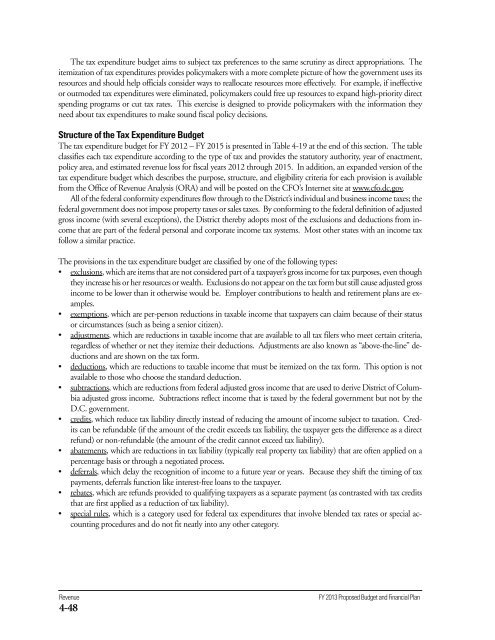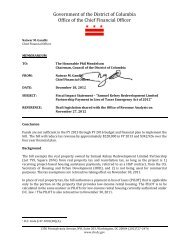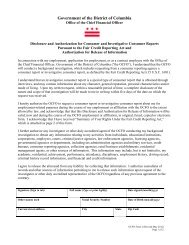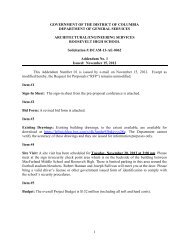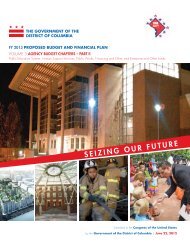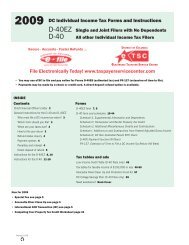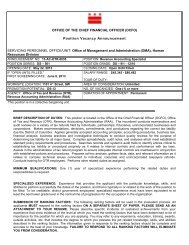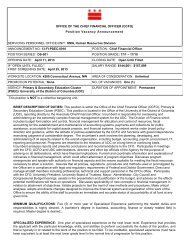Volume 1 - Executive Summary - Office of the Chief Financial Officer
Volume 1 - Executive Summary - Office of the Chief Financial Officer
Volume 1 - Executive Summary - Office of the Chief Financial Officer
Create successful ePaper yourself
Turn your PDF publications into a flip-book with our unique Google optimized e-Paper software.
The tax expenditure budget aims to subject tax preferences to <strong>the</strong> same scrutiny as direct appropriations. The<br />
itemization <strong>of</strong> tax expenditures provides policymakers with a more complete picture <strong>of</strong> how <strong>the</strong> government uses its<br />
resources and should help <strong>of</strong>ficials consider ways to reallocate resources more effectively. For example, if ineffective<br />
or outmoded tax expenditures were eliminated, policymakers could free up resources to expand high-priority direct<br />
spending programs or cut tax rates. This exercise is designed to provide policymakers with <strong>the</strong> information <strong>the</strong>y<br />
need about tax expenditures to make sound fiscal policy decisions.<br />
Structure <strong>of</strong> <strong>the</strong> Tax Expenditure Budget<br />
The tax expenditure budget for FY 2012 – FY 2015 is presented in Table 4-19 at <strong>the</strong> end <strong>of</strong> this section. The table<br />
classifies each tax expenditure according to <strong>the</strong> type <strong>of</strong> tax and provides <strong>the</strong> statutory authority, year <strong>of</strong> enactment,<br />
policy area, and estimated revenue loss for fiscal years 2012 through 2015. In addition, an expanded version <strong>of</strong> <strong>the</strong><br />
tax expenditure budget which describes <strong>the</strong> purpose, structure, and eligibility criteria for each provision is available<br />
from <strong>the</strong> <strong>Office</strong> <strong>of</strong> Revenue Analysis (ORA) and will be posted on <strong>the</strong> CFO’s Internet site at www.cfo.dc.gov.<br />
All <strong>of</strong> <strong>the</strong> federal conformity expenditures flow through to <strong>the</strong> District’s individual and business income taxes; <strong>the</strong><br />
federal government does not impose property taxes or sales taxes. By conforming to <strong>the</strong> federal definition <strong>of</strong> adjusted<br />
gross income (with several exceptions), <strong>the</strong> District <strong>the</strong>reby adopts most <strong>of</strong> <strong>the</strong> exclusions and deductions from income<br />
that are part <strong>of</strong> <strong>the</strong> federal personal and corporate income tax systems. Most o<strong>the</strong>r states with an income tax<br />
follow a similar practice.<br />
The provisions in <strong>the</strong> tax expenditure budget are classified by one <strong>of</strong> <strong>the</strong> following types:<br />
• exclusions, which are items that are not considered part <strong>of</strong> a taxpayer’s gross income for tax purposes, even though<br />
<strong>the</strong>y increase his or her resources or wealth. Exclusions do not appear on <strong>the</strong> tax form but still cause adjusted gross<br />
income to be lower than it o<strong>the</strong>rwise would be. Employer contributions to health and retirement plans are examples.<br />
• exemptions, which are per-person reductions in taxable income that taxpayers can claim because <strong>of</strong> <strong>the</strong>ir status<br />
or circumstances (such as being a senior citizen).<br />
• adjustments, which are reductions in taxable income that are available to all tax filers who meet certain criteria,<br />
regardless <strong>of</strong> whe<strong>the</strong>r or net <strong>the</strong>y itemize <strong>the</strong>ir deductions. Adjustments are also known as “above-<strong>the</strong>-line” deductions<br />
and are shown on <strong>the</strong> tax form.<br />
• deductions, which are reductions to taxable income that must be itemized on <strong>the</strong> tax form. This option is not<br />
available to those who choose <strong>the</strong> standard deduction.<br />
• subtractions, which are reductions from federal adjusted gross income that are used to derive District <strong>of</strong> Columbia<br />
adjusted gross income. Subtractions reflect income that is taxed by <strong>the</strong> federal government but not by <strong>the</strong><br />
D.C. government.<br />
• credits, which reduce tax liability directly instead <strong>of</strong> reducing <strong>the</strong> amount <strong>of</strong> income subject to taxation. Credits<br />
can be refundable (if <strong>the</strong> amount <strong>of</strong> <strong>the</strong> credit exceeds tax liability, <strong>the</strong> taxpayer gets <strong>the</strong> difference as a direct<br />
refund) or non-refundable (<strong>the</strong> amount <strong>of</strong> <strong>the</strong> credit cannot exceed tax liability).<br />
• abatements, which are reductions in tax liability (typically real property tax liability) that are <strong>of</strong>ten applied on a<br />
percentage basis or through a negotiated process.<br />
• deferrals, which delay <strong>the</strong> recognition <strong>of</strong> income to a future year or years. Because <strong>the</strong>y shift <strong>the</strong> timing <strong>of</strong> tax<br />
payments, deferrals function like interest-free loans to <strong>the</strong> taxpayer.<br />
• rebates, which are refunds provided to qualifying taxpayers as a separate payment (as contrasted with tax credits<br />
that are first applied as a reduction <strong>of</strong> tax liability).<br />
• special rules, which is a category used for federal tax expenditures that involve blended tax rates or special accounting<br />
procedures and do not fit neatly into any o<strong>the</strong>r category.<br />
Revenue<br />
4-48<br />
FY 2013 Proposed Budget and <strong>Financial</strong> Plan


